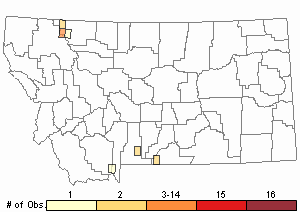View in other NatureServe Network Field Guides
NatureServe
Montana
Utah
Wyoming
Idaho
Wisconsin
British Columbia
South Carolina
Yukon
California
New York
Three-flowered Rush - Juncus triglumis var. albescens
Other Names:
Juncus albescens
State Rank Reason (see State Rank above)
Rare in Montana, where it is known from a few, moist, alpine sites in Glacier National Park and the Absaroka-Beartooth Mountains. The potential for negative impacts from human-caused activities appears to be minimal.
General Description
Three-flowered Rush is a small, tufted, grass-like perennial with stems that are 5-15 cm high. The basal leaves are 2-10 cm long, round in cross-section, and divided internally into sections (septate). Stem leaves are lacking. 2-4 flowers are borne in a solitary, terminal cluster that is subtended by 2 brown, papery bracts which are as long as the head. Each flower is subtended by a single scale-like bract and has 6 pale brown perianth segments, or tepals, that are ca. 4 mm long with rounded tips. There are 6 stamens. The brown capsule is 3-5 mm high and is rounded on top with a short beak; it is about as long as the tepals. Each seed is 1-2 mm long with a narrow, papery wing on each end.
Phenology
Mature fruit in July-August.
Diagnostic Characteristics
Of the small, high alpine rushes, JUNCUS CASTANEUS has larger flowers, and J. BIGLUMIS has only 2 flowers and capsules that are indented on top. In VAR TRIGLUMIS, the bracts are shorter than the flower head, and the mature capsules are 4-7 mm long, exserted beyond the dark brown tepals. JUNCUS is a large and difficult genus to distinguish, so a technical key should be consulted. Mature fruit is necessary for positive determination.
Species Range
Montana Range
Range Descriptions

 Native
Native
Range Comments
Alaska to Newfoundland, south to British Columbia, Montana, Utah, and Colorado.
Observations in Montana Natural Heritage Program Database
Number of Observations: 22
(Click on the following maps and charts to see full sized version)
Map Help and Descriptions
Relative Density

Recency



 (Observations spanning multiple months or years are excluded from time charts)
(Observations spanning multiple months or years are excluded from time charts)
Habitat
Wet, organic soils and moist, well-developed turf in the alpine zone.
National Vegetation Classification System Groups Associated with this Species
Alpine
Alpine - Vegetated
Wetland and Riparian
Alpine Riparian and Wetland
Wet Meadow and Marsh
Stewardship Responsibility
Threats or Limiting Factors
STATE THREAT SCORE REASON
Threat impact not assigned because threats are not known (MTNHP Threat Assessment 2021).
References
- Literature Cited AboveLegend:
 View Online Publication
View Online Publication MTNHP Threat Assessment. 2021. State Threat Score Assignment and Assessment of Reported Threats from 2006 to 2021 for State-listed Vascular Plants. Botany Program, Montana Natural Heritage Program, Helena, Montana.
MTNHP Threat Assessment. 2021. State Threat Score Assignment and Assessment of Reported Threats from 2006 to 2021 for State-listed Vascular Plants. Botany Program, Montana Natural Heritage Program, Helena, Montana.
- Additional ReferencesLegend:
 View Online Publication
View Online Publication
Do you know of a citation we're missing? Bamberg, S. A., and J. Major. 1968. Ecology of the vegetation and soils associated with calcareous parent materials in three alpine regions of Montana. Ecological Monographs 38(2):127-167.
Bamberg, S. A., and J. Major. 1968. Ecology of the vegetation and soils associated with calcareous parent materials in three alpine regions of Montana. Ecological Monographs 38(2):127-167. Hermann, F.J. 1975. Manual of the rushes (Juncus spp.) of the Rocky Mountains and Colorado basin. U.S. Forest Service, General Technical Report RM-18.
Hermann, F.J. 1975. Manual of the rushes (Juncus spp.) of the Rocky Mountains and Colorado basin. U.S. Forest Service, General Technical Report RM-18. Hermann, F.J. and W.A. Weber. 1977. Juncus triglumis in North America. Rhodora 79:160-162.
Hermann, F.J. and W.A. Weber. 1977. Juncus triglumis in North America. Rhodora 79:160-162. Lesica, P. and B. McCune. 1992. Monitoring the effects of global warming using peripheral rare plants in wet alpine tundra in Glacier National Park, Montana. Unpublished report to Glacier National Park, Research Division, West Glacier, Montana 59936. 55pp.
Lesica, P. and B. McCune. 1992. Monitoring the effects of global warming using peripheral rare plants in wet alpine tundra in Glacier National Park, Montana. Unpublished report to Glacier National Park, Research Division, West Glacier, Montana 59936. 55pp. Lesica, P., M.T. Lavin, and P.F. Stickney. 2012. Manual of Montana Vascular Plants. Fort Worth, TX: BRIT Press. viii + 771 p.
Lesica, P., M.T. Lavin, and P.F. Stickney. 2012. Manual of Montana Vascular Plants. Fort Worth, TX: BRIT Press. viii + 771 p. Lesica, P., M.T. Lavin, and P.F. Stickney. 2022. Manual of Montana Vascular Plants, Second Edition. Fort Worth, TX: BRIT Press. viii + 779 p.
Lesica, P., M.T. Lavin, and P.F. Stickney. 2022. Manual of Montana Vascular Plants, Second Edition. Fort Worth, TX: BRIT Press. viii + 779 p. Williams, K.L. 2012. Classification of the grasslands, shrublands, woodlands, forests and alpine vegetation associations of the Custer National Forest portion of the Beartooth Mountains in southcentral Montana. M.Sc. Thesis. Bozeman, MT: Montana State University. 376 p.
Williams, K.L. 2012. Classification of the grasslands, shrublands, woodlands, forests and alpine vegetation associations of the Custer National Forest portion of the Beartooth Mountains in southcentral Montana. M.Sc. Thesis. Bozeman, MT: Montana State University. 376 p.
- Web Search Engines for Articles on "Three-flowered Rush"





